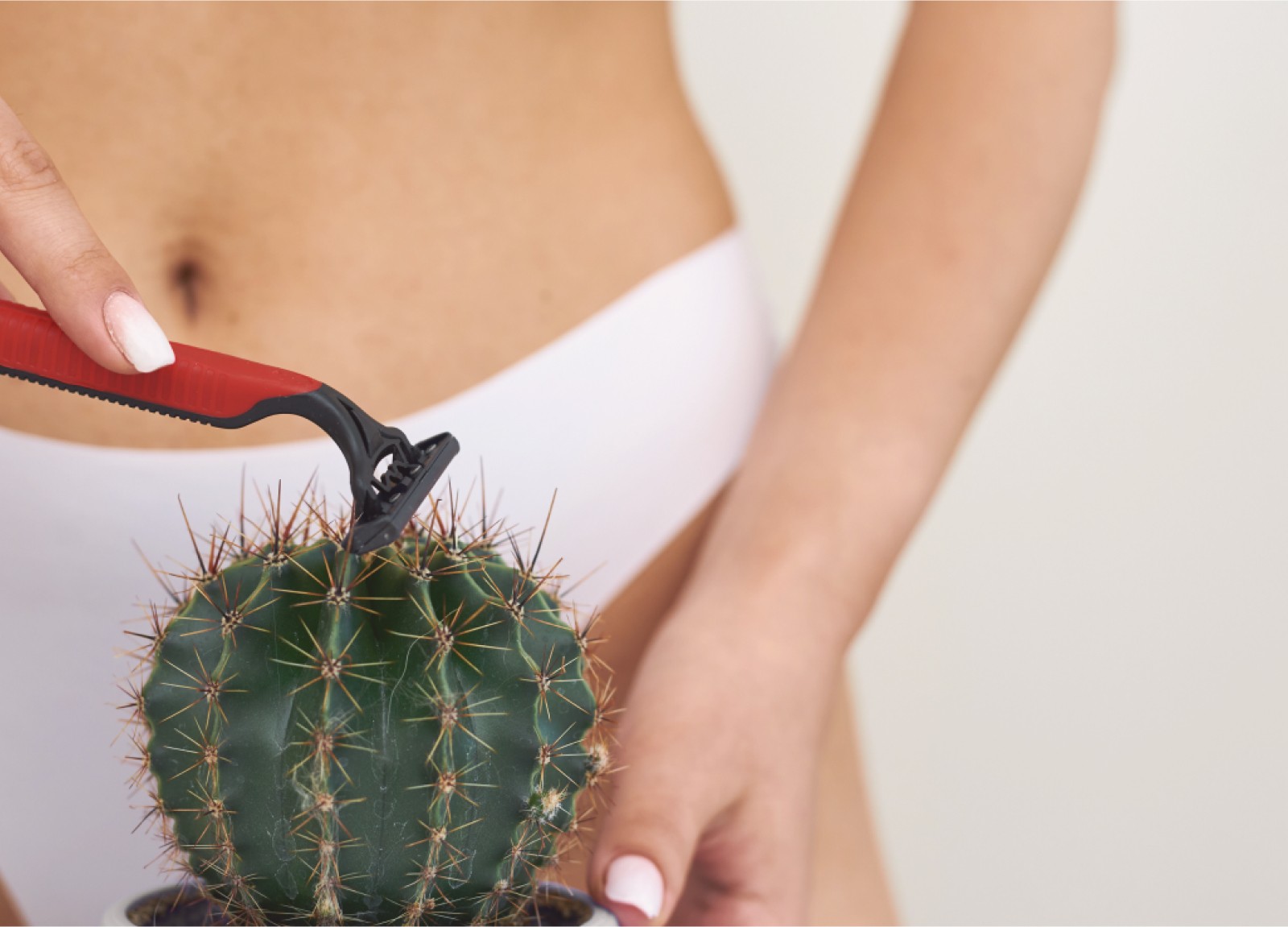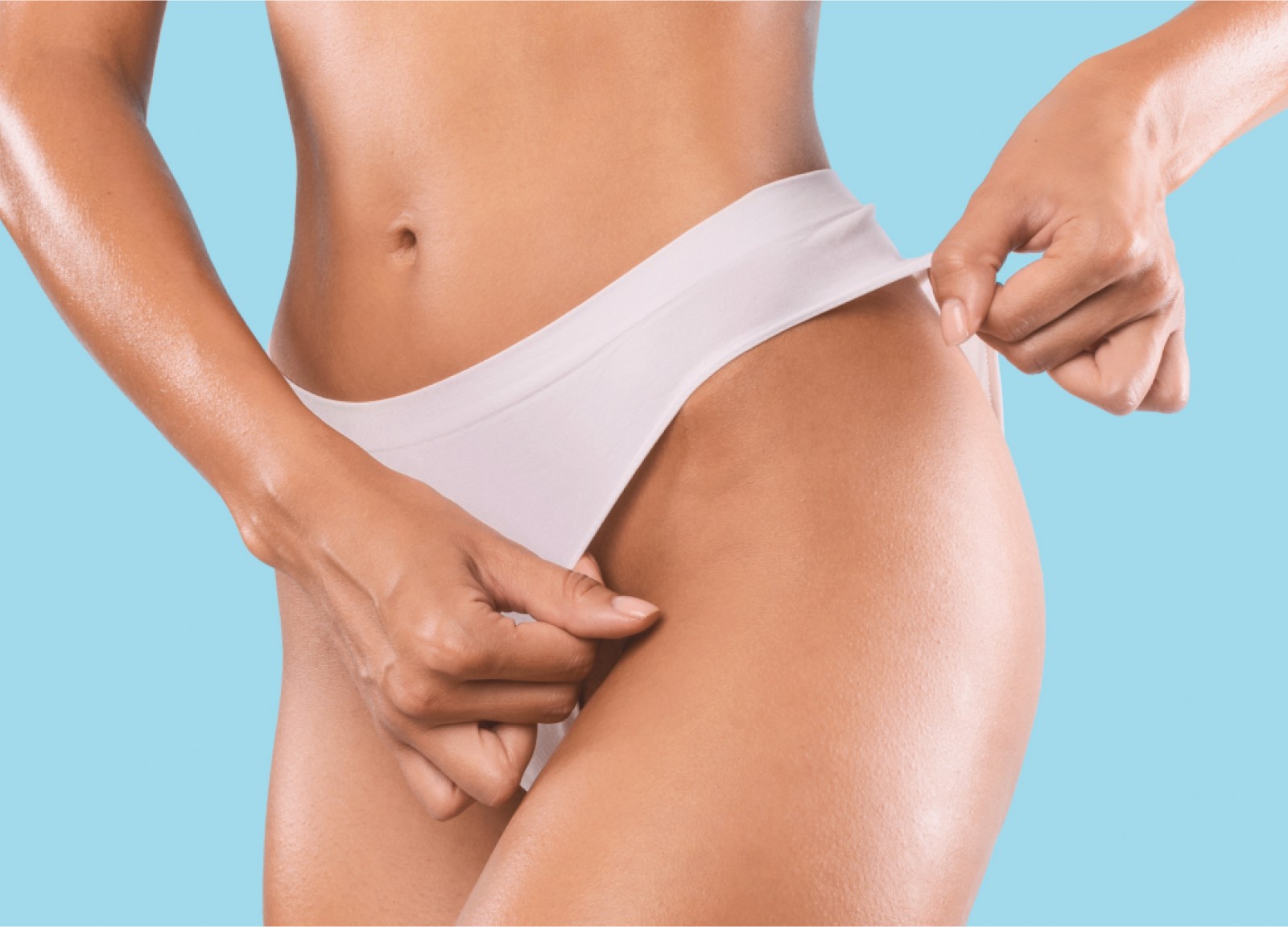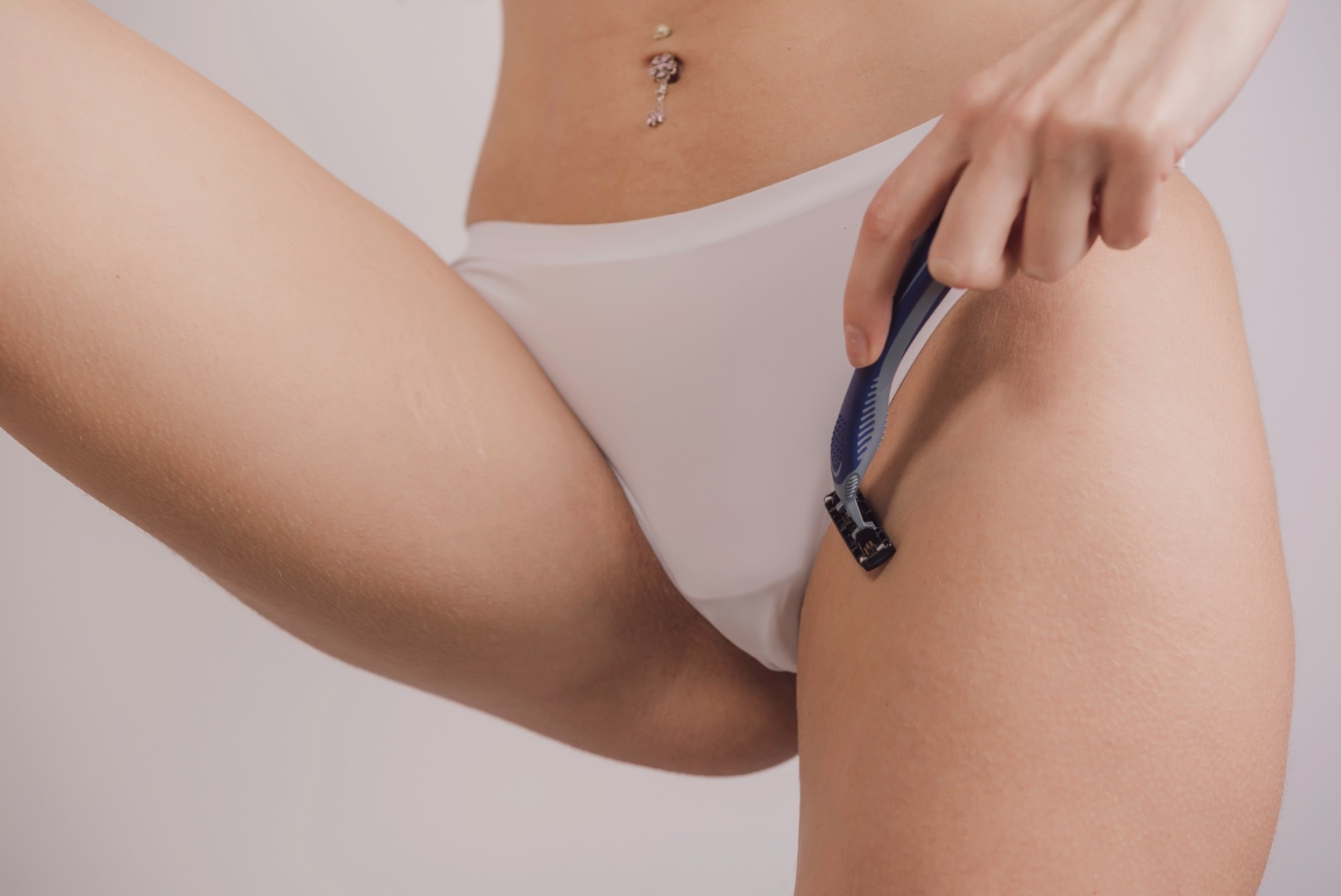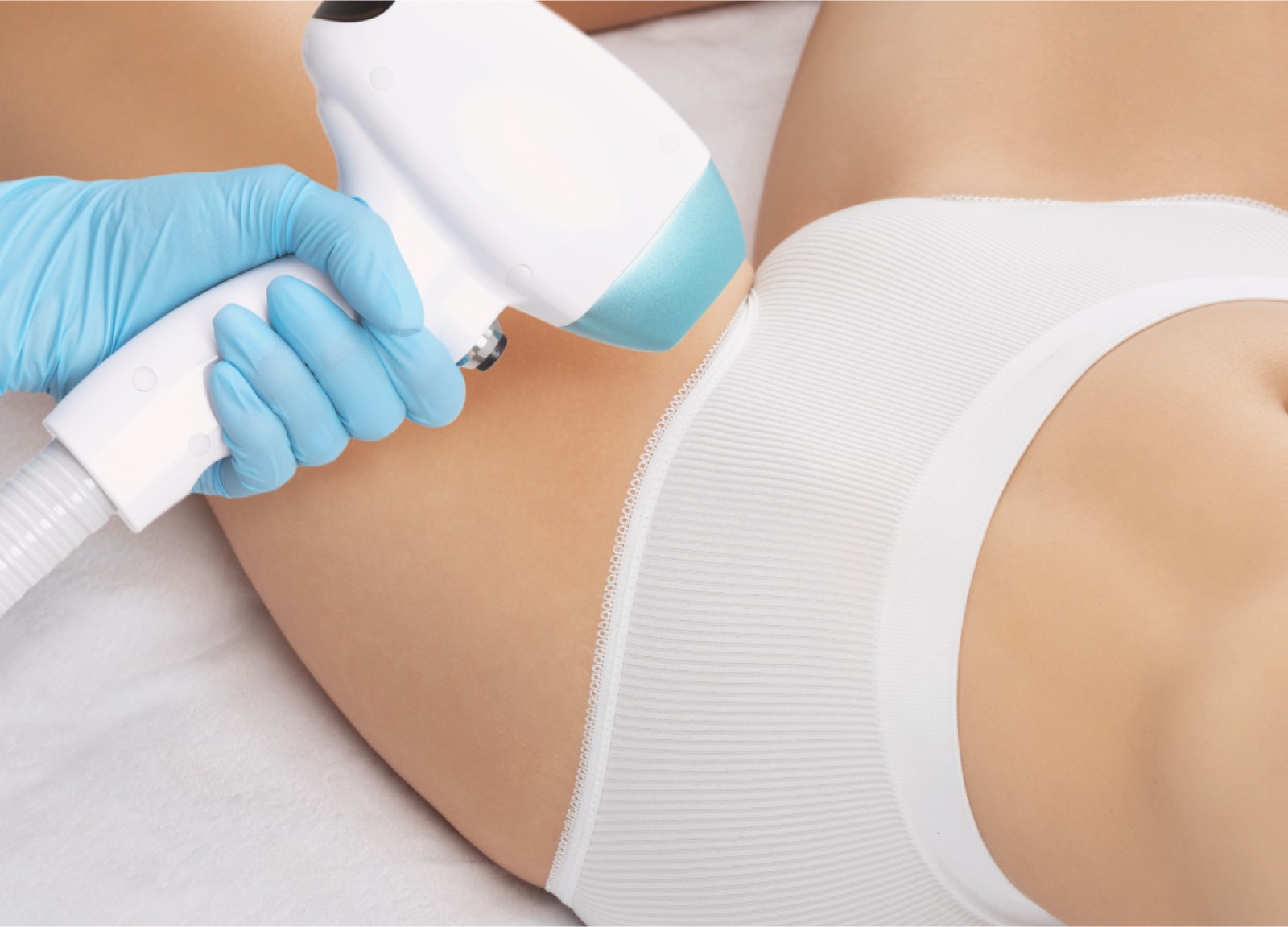Ingrown hairs in intimate areas are not only an aesthetic issue but also a health concern. What causes hairs to change direction and grow back into the skin instead of growing straight? Let’s take a look at the most common causes of this phenomenon, how to prevent it, and how to address it.
Obsah
However, there is only one procedure that provides a long-term solution and prevention at the same time. Professional laser hair removal eliminates hair along with the follicle, leaving your skin perfectly smooth for years. Experience its effects in our salon!
What is ingrown hairs in the private parts, its causes and consequences
What we mean by an ingrown hair
An ingrown hair is a relatively common occurrence that happens when a shaved, plucked, or otherwise removed hair begins to grow back into the skin instead of growing out.
The body reacts to this “foreign” object invading the skin, typically resulting in irritation, uncomfortable inflammation, and the formation of red bumps.
This problem can occur anywhere on the body where shaving or other hair removal methods are used, including the scalp, although such cases are much less common. Conversely, ingrown hairs are most frequently seen on the legs, underarms, and in intimate areas.
Ingrown hairs in the groin are a concern for many of us whose hair has a natural tendency to curl. However, it can affect anyone, and there are several causes for this phenomenon. Let’s take a look at what they are.

Why do ingrown hairs appear in intimate places?
There are several reasons for the appearance of ingrown hairs. By far the most common are:
Genetics
Did your parents gift you with curly or coarse hair? If so, you may be more prone to ingrown hairs. Curly hairs tend to bend and grow back into the skin after shaving or epilating.
Of course, we’re not saying that this fate will necessarily affect every curly-haired person, but it’s important to be aware of the increased risk and to take steps to reduce it. Whether through proper skin care or by choosing hair removal methods like laser hair removal, which can prevent any future ingrown hairs.
Improper shaving technique
Are you sure you’re not causing ingrown hairs yourself by using improper shaving techniques? For example, shaving against the direction of hair growth or using dull blades can lead to exactly that. After such shaving, the hair often remains with a sharp end, making it easier to penetrate back into the skin.
If shaving is your preferred method, always ensure you’re doing it correctly and using high-quality razors and blades to prevent these issues.
Complications with other methods of hair removal
Instead of shaving, do you prefer waxing or tweezing to other groin hair removal methods? Waxing or tweezing removes hair from the skin, including the root, which means that hair regeneration occurs more slowly than with shaving. You can enjoy smooth skin for several weeks.
But beware here too.
On the other hand, once the hair starts to regenerate, it may change direction and grow back into the skin instead!
Tight clothing
Wearing tight underwear can irritate the skin, cause moisture buildup, and create an ideal environment for bacteria to thrive. These bacteria can enter the pores, clog them, and prevent the hairs from growing naturally.
The presence of bacteria can also worsen the inflammation that the body reacts with to ingrown hairs or may directly cause inflammation.
Additionally, tight clothing itself can impede proper hair growth. If a hair encounters such an obstacle, it may change direction and start growing back into the skin.
Neglected skin care
If you don’t follow intimate hygiene practices and fail to exfoliate the skin regularly, dead and unremoved skin cells can start to block the follicles, making it difficult for hairs to grow to the surface.
Exfoliation and hygiene in the intimate area are among the best preventive measures against this problem.
Folliculitis and other complications
Inflammation is usually the result of ingrown hairs. Sometimes, however, it can be the opposite of its cause.
Inflammatory diseases such as folliculitis disrupt normal hair growth and lead to pimples and festering, painful bumps.
Another complication in the normal growth of hair is a condition called keratosis pilaris, in which the skin overproduces keratin and develops rough and leathery bumps to the touch. These can become an obstacle to hair growth.
What are the physical manifestations of ingrown hairs
Red or pink pimples
If small, visible red or pink bumps appear on your skin, it often indicates that a hair is growing back into the skin.
Pain or itching
The area where the hair is ingrown is usually painful and itchy. This is a natural reaction of the body to irritation.
Pustule
Sometimes, a small bump forms around the ingrown hair, similar to a pimple—a sort of “zit.” This bump may be filled with pus as a response from the body to an infection.
Hyperpigmentation
In some cases, hyperpigmentation, or small pigmented spots, may develop around the area of the ingrown hair.
Thickened skin
Chronic ingrown hairs can lead to thickening or hardening of the skin in the affected area.
Visible hair
Sometimes, ingrown hairs beneath the skin can be seen with the naked eye.

Health and other problems associated with ingrown hairs
Few places are as uncomfortable as the delicate and sensitive skin of the intimate area, which paradoxically grows hair thicker and stiffer than other parts of the body.
Add to this the fact that these areas are enclosed in tight underwear for most of the day, so the skin tends to sweat and steam, and your problem is multiplied.
What exactly makes the existence of ingrown hairs most annoying?
Itchy, scratchy and not at all pleasant
The hairs don’t even have to grow in any great quantity. It only takes a few and they start to itch. Not to mention that scratching yourself in intimate places will only bring temporary relief. The annoying itch often comes back even stronger after a while.
As soon as you are affected by such ingrown hairs, you can also forget about playing sports, which will make the problem worse by sweating. Your intimate life is also likely to suffer from ingrown hairs.
They’re not pleasant to look at
Your dream of perfectly smooth intimate areas has faded. Instead of velvety, smooth skin, you now have red, often pus-filled bumps that fall far short of the desired aesthetic effect. Your self-confidence is at an all-time low; you feel embarrassed about the appearance of your intimate areas and would rather shut yourself away at home from the whole world.

Health complications
Not only are ingrown hairs unattractive, but they can also lead to a range of health complications, such as:
Folliculitis
Ingrown hairs often cause inflammation of the hair follicles, leading to swelling and painful pus-filled bumps. Pseudofolliculitis, resembling acne, can also occur.
Infections
The problem worsens if an infection enters the inflamed areas and bumps, perhaps as a result of excessive scratching. The area may swell, become more painful, and in severe cases, may require medical attention. v
Hyperpigmentation
As mentioned earlier, inflammation can affect skin pigmentation. Repeated ingrown hairs can lead to the development of unsightly pigmented spots.
Scar formation
Chronic ingrown hairs can lead to scar formation, especially if the affected areas are frequently irritated or scratched.
Traditional hair removal methods and their drawbacks
The vast majority of people resort to some traditional methods in the battle against hair. However, unknowingly, they may increase the risk of ingrown hairs!
The most popular hair removal methods include:
Shaving with a razor or electric shaver
Undoubtedly the most widespread method. People choose it for its relative ease, speed, and painlessness. The drawbacks? Hairs start to regrow within just two days, so you may find yourself shaving repeatedly without ever achieving truly smooth skin. Poor shaving technique also increases the risk of ingrown hairs.
Waxing
A painful but effective method for achieving smooth skin for several weeks. Wax or waxing strips are applied to the area and then quickly pulled off against the direction of hair growth. Not recommended for sensitive intimate areas!
Sugar waxing
Works similarly to waxing but is considered a slightly gentler method. Still, it is not the most pleasant experience.
Mechanical or electric epilation
There are also various commercial epilators, whether mechanical or electric, that can remove hair by pulling it out or using electric discharge. Unlike laser hair removal, hair will regrow over time, making this a short-term solution. Additionally, it is not entirely pain-free, even for epilators specifically designed for intimate areas.

How to reduce the risk of ingrown hairs
- Always use a sharp razor or razor blade. Dull blades can tear hairs instead of a smooth cut. This dramatically increases the risk of ingrowth. So change razors and blades regularly to keep them as sharp as possible.
- Gentle exfoliation before shaving or waxing removes dead skin cells and allows hair to grow more freely. So try to exfoliate regularly, typically twice a week.
- Use moisturizing shaving products. Shaving creams or foams help protect and moisturize the skin, which reduces the likelihood of irritation and ingrown hairs. For sensitive intimate areas, try to choose products designed specifically for them, without perfume, alcohol or harmful dyes.
- Shave in the direction of hair growth, not against it. This reduces irritation and the potential for ingrown hairs. On the other hand, shaving against the grain can give you a smoother shave. But it's riskier - the choice is yours.
- After shaving or epilating, apply a soothing and moisturizing aftershave or gel to the shaved areas. This will help keep the skin moisturised and minimise the risk of ingrown hairs.
When classic methods frustrate you....
From the above, the main weakness of traditional methods clearly emerges. First and foremost, it’s the temporary nature, which is evident with shaving; however, no other methods offer more than just a few weeks of relief from hair.
You will end up wasting time on repeated procedures, spending money on new razors, depilatory waxes, creams, lotions, or salon treatments, and after a while, you’ll feel that maintaining smooth skin is truly a Sisyphean task.
The worst part is that you won’t do anything against ingrown hairs. You won’t reduce the risk; in fact, it may increase. With every shave and depilation, you face the same threat anew.
One bad shave can change the direction of hair growth, and suddenly the problem arises. With waxing, sugaring, or home epilators, there’s a risk that weakened hairs will start curling and growing in unnatural directions.
So what works one hundred percent against ingrown hairs? Let’s introduce a solution called laser hair removal.

Laser hair removal offers a long-term solution
Do you know how laser hair removal in intimate areas works?
The laser beam from the device targets the hairs in the treated area and transforms into intense thermal energy, perfectly destroying the hair, including the bulb responsible for its continual regrowth.
As the only method, it offers a truly permanent solution. In a relatively small area like the intimate regions, a single session of laser hair removal typically takes no more than 10-15 minutes.
However, keep in mind that the laser can only destroy hairs in the growth phase, which are not always all of them. For full effect, an estimated 5-6 repeated sessions, spaced a few weeks apart, are necessary.
Overall, the procedure takes several months to achieve perfect hair removal in the intimate area. This may seem like a long time, but know that the result can be years of freedom from further hair concerns.
One of the biggest problems that laser hair removal alleviates is indeed ingrown hairs. You simply won’t have any hairs left to ingrow!
The best part is how gentle laser hair removal is compared to other methods. Modern lasers are usually equipped with professional cooling systems, and specialists can offer soothing creams for those with sensitive skin.
In such a sensitive area as the intimate regions, maximum gentleness is essential. And that’s precisely what laser hair removal embodies.





